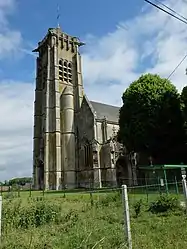Écoust-Saint-Mein
Écoust-Saint-Mein is a commune in the Pas-de-Calais département in the Hauts-de-France region of France.[3]
Écoust-Saint-Mein | |
|---|---|
 The church of Écoust-Saint-Mein | |
 Coat of arms | |
Location of Écoust-Saint-Mein | |
 Écoust-Saint-Mein  Écoust-Saint-Mein | |
| Coordinates: 50°10′57″N 2°54′39″E | |
| Country | France |
| Region | Hauts-de-France |
| Department | Pas-de-Calais |
| Arrondissement | Arras |
| Canton | Bapaume |
| Intercommunality | CC Sud-Artois |
| Government | |
| • Mayor (2020–2026) | Olivier Houplain[1] |
| Area 1 | 8.43 km2 (3.25 sq mi) |
| Population | 490 |
| • Density | 58/km2 (150/sq mi) |
| Time zone | UTC+01:00 (CET) |
| • Summer (DST) | UTC+02:00 (CEST) |
| INSEE/Postal code | 62285 /62128 |
| Elevation | 84–117 m (276–384 ft) (avg. 97 m or 318 ft) |
| 1 French Land Register data, which excludes lakes, ponds, glaciers > 1 km2 (0.386 sq mi or 247 acres) and river estuaries. | |
Geography
Écoust-Saint-Mein is a farming village situated 10 miles (16 km) southeast of Arras at the junction of the D956 and D5 roads.
History
During World War I, Écoust-Saint-Mein was located on the Hindenburg Line when its inhabitants were evacuated by German forces. The church tower was mined and served as a landmark for gunners. Following the battle of Arras in 1917, it was captured by the Allies until it was recaptured by the Germans in March 1918 and finally retaken on 3 September 1918.
Population
| Year | Pop. | ±% p.a. |
|---|---|---|
| 1968 | 466 | — |
| 1975 | 453 | −0.40% |
| 1982 | 468 | +0.47% |
| 1990 | 443 | −0.68% |
| 1999 | 429 | −0.36% |
| 2007 | 487 | +1.60% |
| 2012 | 506 | +0.77% |
| 2017 | 491 | −0.60% |
| Source: INSEE[4] | ||
Places of interest
- The church of St. Mein, dating from the sixteenth century.
- Traces of an old castle.
- World War I cemeteries.
In popular culture
In the 2019 film 1917, Écoust-Saint-Mein is depicted as a ruined waypoint on the mission of the main character. The film's depiction of the town is largely based on actual history. As the town became a war zone during the First World War, the villagers had no choice but to abandon Écoust-Saint-Mein, returning after the war to rebuild. Fictional elements were also integrated, however, such as the river crossing the town.
References
- "Répertoire national des élus: les maires". data.gouv.fr, Plateforme ouverte des données publiques françaises (in French). 9 August 2021.
- "Populations légales 2020". The National Institute of Statistics and Economic Studies. 29 December 2022.
- INSEE commune file
- Population en historique depuis 1968, INSEE